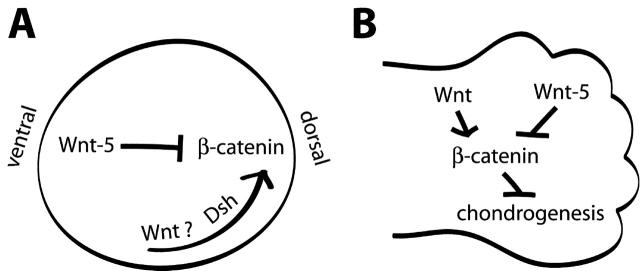Figure 1.
Vertebrate Wnt-5 paralogues antagonize Wnt/β-catenin signaling. (A) A highly schematized model of antagonistic interactions of maternal Wnt signaling pathways in early Xenopus or zebrafish embryos. In response to Dishevelled (Dsh) and perhaps a Wnt signal, high β-catenin levels specify the dorsal side. Maternal Wnt-5 is required for development of ventral cell fates by antagonizing β-catenin signaling, although where Wnt-5 is active remains unclear. (B) A simplistic model of Wnt antagonism in the mouse limb bud. The limb ectoderm and apical ectodermal ridge (AER) meet at the distal limb bud. As several Wnts (e.g., Wnt7a or Wnt3) that are able to activate canonical Wnt/β-catenin signaling are expressed in the limb ectoderm and apical ectodermal ridge, the distal limb bud has a higher level of canonical Wnt/β-catenin signaling, which suppresses chondrogenesis. In the distal limb bud, Wnt-5a signaling decreases β-catenin levels, which allows chondrogenesis to occur.

